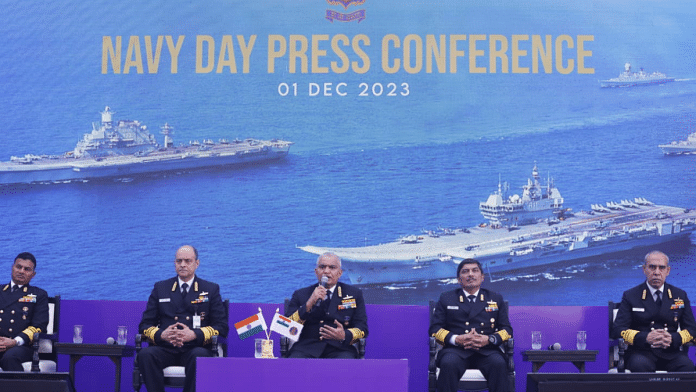New Delhi: The Indian Navy has started work on building the next generation of more advanced and capable destroyers, and plans for these vessels are “already on the drawing board”, Vice Chief of Naval Staff, Vice Admiral Sanjay Jasjit Singh said Friday.
Destroyers are fast, manoeuvrable and long-endurance warships that provide multi-mission offensive and defensive capabilities.
“The broad timeframe is about five years from now. By then, we should be in a position to target the contract, and within five to 10 years, entire delivery,” said Vice Admiral Singh at the press conference organised annually ahead of Navy Day on 4 December. The event was also attended by Navy Chief, Admiral R. Hari Kumar.
Singh added: “We have P-15 Alpha (Kolkata-class) and P-15 Bravo (Visakhapatnam-class) destroyers, which have hugely successful designs. They are purely designed by our indigenous design bureau. With each level and generation, we have learnt a lot and have been able to add to the combat capability.”
Speaking about the Imphal, the third warship in the P-15B series which was delivered in October, Vice Admiral Singh said, “Today, we have the Imphal, which we are due to commission by the end of this year. It has achieved milestones, which are approximately 50 percent of what we used to take 20 years ago (in terms of indigenous construction and the pace of manufacturing).”
Imphal, which is being touted as one of the largest destroyers built in India, is armed with supersonic surface-to-surface ‘Brahmos’ missiles and ‘Barak-8’ Medium Range Surface to Air Missiles (MRSAM).
Singh added: “So, we are fairly confident that we will be able to get in the entire range of the next-generation destroyers, which will be pitched approximately at 10,000 tonnage, multi-role with absolute state-of-the-art (and) absolutely indigenous combat capability.”
According to the Navy Chief, there are currently 67 warships which are under construction, of which 65 are being built in India. “The number of ships that the Navy is targeting to have by 2035 is 170 to 175,” he added.
To a question asked by ThePrint on the status of the next aircraft carrier, Admiral Kumar said the Navy was awaiting the ‘acceptance of necessity’ (AoN) from the Defence Acquisition Council (DAC) and the process is likely to take another year.
Regarding the acquisition of Rafale-Marine fighters — of which India is reported to get 26 — he added that while the DAC has approved buying of the aircraft, India has sent in a Letter of Request (LOR) to the French manufacturer Dassault Aviation and they have to come back with the price, after which negotiations will follow.
Also Read: Navy set to withdraw its ceremonial uniform ‘No.2’, replace it with half-sleeved shirt & trousers
Indian shipyards and their capability
Talking about the capability of Indian shipyards, Admiral Kumar said that over a period of time, Indian shipyards have built a capacity and capability to build ships of different types.
“The process had started as early as the 1960s. But it has strengthened over a period of time. The culmination of this capability and capacity development is the commissioning of Vikrant [aircraft carrier] and its full operationalisation. There are barely five to six countries that can build an aircraft carrier,” he added.
According to the Navy Chief, Indian shipbuilding has developed drastically and it is now almost of contemporary world standards, in terms of building complex destroyers and modern-generation destroyers.
“We feel that with new programmes like P75-India, where we are looking at strategic partnerships with the Indian companies, we will be able to design, develop and produce our own submarines, ships and aircraft,” he added.
P75-India is an acquisition programme for the procurement of diesel-electric attack submarines with air-independent propulsion systems.
In his address, Admiral Kumar also spoke about China’s naval presence and said it has a presence of six to eight ships in the Indian Ocean Region (IOR).
“They also have Chinese research vessels, which conduct surveys in the international waters. There is a sustained presence in the IOR (of Chinese ships). We are cognisant of that and take actions to monitor their activities,” he added.
On naval fighters
The Navy chief said that in terms of aircraft, India was looking at Twin Engine Deck Based Fighters (TEDBF) as a replacement to the MiG-29Ks, which will be phased out starting 2034.
The TEDBF multi-role combat aircraft would be built in India by Hindustan Aeronautics Limited (HAL) and the specifications have already been prepared, he said, adding, that a prototype is expected in four to six years and the production will take another two to three years after that.
“We hope that by 2032 onwards, we will be able to get these TEDBF for operations from our carrier. Ships, submarines, aircraft and helicopters are all going to be made in India,” he added.
In his address, Admiral Kumar also spoke about new-age disruptive technologies, which would be developed in the country.
“We are looking at niche disruptive technologies that we can develop in Bharat, for Bharat and exclusively for Bharat.” He added that these are technologies, which are of interest to us, and India does not need to share with other countries.
(Edited by Richa Mishra)
Also Read: Replacing ageing Cheetah/Chetak choppers to take at least 10 yrs, hopes pinned on LUH & leasing



